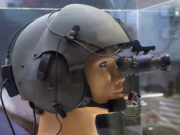Because some light-emitting diode (LED) obstruction lights cannot be seen by wearers of night vision goggles (NVGs), crews and aircraft operators must take additional steps to ensure that pilots avoid obstacles marked with LEDs, the U.S. Federal Aviation Administration (FAA) says.
Safety Alert for Operators (SAFO) 18010, issued earlier in September, cited the recent report by the pilot of an emergency medical services helicopter of a near miss with a tower that had been marked with LED obstruction lighting. The pilot had been wearing NVGs; a crewmember who was not wearing goggles saw the tower and pointed it out to the pilot, the FAA said.
The FAA noted that it had warned in 2009, in SAFO 09007, that some LED lighting systems “fall outside the combined visible and near-infrared spectrum of NVGs and thus will not be visible to flight crew using NVGs.” The 2009 SAFO recommended that pilots be informed of the limitations of LED obstruction lights and that the information be included in pilot NVG training programs.
The new SAFO outlined an additional FAA recommendation calling for air carriers and operators, as well as those governed by the general operating regulations of Federal Aviation Regulations Part 91, incorporate into manuals and standard operating procedures (SOPs) a requirement for “unaided scanning” at low altitudes — that is, scanning by someone not using NVGs.
“This may be accomplished by looking under or to the sides of the NVGs or by briefly placing the NVGs in the stowed (flipped up) position,” the SAFO said. “Manuals/SOPs should include crew resource management procedures for addressing LED-lit obstructions to the pilot flying. For instance, non-flying personnel should make periodic unaided scans and point out the obstruction(s) to the pilot, e.g., ‘LED lit tower, two o’clock.’ It is also recommended that a landing be aborted and/or a climb to a higher altitude be initiated any time the location of an obstruction is not clear to the pilot.”
The SAFO also asked operators and pilots to report encounters with non-NVG compatible obstruction lighting to the Aviation Safety Reporting System at https://asrs.arc.nasa.gov.


